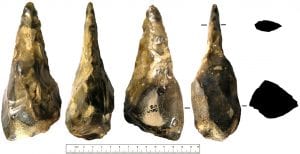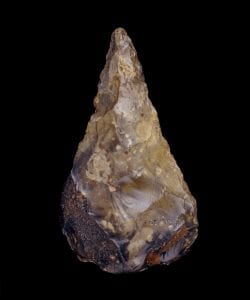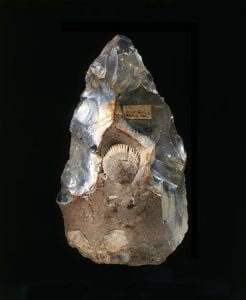What are the Oldest Artefacts in Egypt?
By Josie Mills, on 21 September 2018
The oldest artefacts in the Petrie Museum weren’t made by the Ancient Egyptians or at least the people we associate with pyramids, mummies and hieroglyphs. They may look unassuming, but these amber coloured stones are handaxes that were made by our human ancestors around half a million years ago. These are my favourite artefacts in the museum even though they aren’t shiny or gilded but because they shed light on hominin behaviour in Egypt before the Egyptians.

These stone tools were made by hominins who lived in Egypt around half a million years ago, making them around 495,000 years older than the earliest ‘Egyptians’! It’s likely that Egypt was occupied by hominins during cooler periods when river systems and vegetation provided a suitable habitat. Lots of these handaxes were found on river terraces suggesting these waterways were an important part of life. Petrie Museum accession numbers: UC 13572 UC75136 UC13579 UC13527 left to right. (Author’s own image)
Archaeologists call this type of artefact a lithic, which means ‘made of stone’, usually flint or other siliceous rock. Flint is a very hard rock that is part of the chert family and is particularly useful for making tools because it fractures like glass creating very sharp edges. Stone tools are a very important record left behind by hominins and they are often the only thing we find on stone age sites because they preserve well and don’t decay. Handaxes, also called bifaces, are a particularly recognisable tool because of their distinctive shape.
Handaxe is a term we use to describe a stone tool that has been shaped bifacially (on both sides) by the removal of flint flakes, a process called knapping. There are lots of different shapes of handaxe; for example, those that are more oval are called ovate handaxes whereas those with a wider butt (technical term!) and shaped to a point are called ficrons. They were used throughout the Lower and Middle Palaeolithic.

This is an example of a ficron handaxe. A lot of ficrons are made on pebbles, often from flint cobbles transported by rivers or glaciers. Here you can see that the natural shape of the pebble has been used as the base of the handaxe with the remaining portion knapped into a point. (Image credit: The Portable Antiquities Scheme/ © The Trustees of the British Museum)
It’s likely that handaxes had many different uses but were primarily employed to process carcasses, enabling hominins to get the most meat possible from the animals they hunted or scavenged. It’s thought that they were also used to dig for tubers and process organic materials. The shape of the tool meant that they could be easily re-sharpened by removing the blunted edge revealing sharp flint underneath. This ability to rejuvenate the tool means that handaxes were highly portable tools that could be shaped and adapted on the move.

This handaxe is from the Middle Palaeolithic site La Cotte a La Chèvre on Jersey. It is relatively small and has probably been re-sharpened multiple times. During the Middle Palaeolithic the landscape to the north of Jersey was used by highly mobile Neanderthals hunting and gathering. It’s likely that this handaxe was part of a Neanderthal tool-kit and may have been discarded at the cave because it had been re-sharpened so much it was too small to use! (Image Credit: Jersey Heritage)
The idea that handaxes were made by humans rather than environmental or supernatural processes was popularised by John Frere in 1800. Frere discovered an assemblage of handaxes and animal bones in a gravel deposit at the site of Hoxne in Sussex. Although Frere was the first to publish this idea others before him, for example John Conyers who was present at the discover of the Gray’s Inn Handaxe in 1679, had suggested it but not been taken seriously. Prior to the 19th Century the origin of handaxes was often explained through folklore, they were often called ‘thunder stones’, the lithified remnants of lightning bolts, or ‘elf-shot’, the preserved remains of tiny weapons.

This is the handaxe found at the Gray’s Inn Road site by John Conyers in 1679. (Image credit: © The Trustees of the British Museum)
Although it’s generally accepted that handaxes are a practical tool, there are several instances of bifaces that are simply too big to function. This handaxe (below) discovered at Furze Platt in Maidenhead, UK, is around 30cm long and would have been very heavy! These oversized axes led to the theory that bifaces influenced sexual selection; the larger your handaxe, the more proficient you were at provisioning resources and important raw material. In this scenario your giant handaxe suggests that you are a great option for a partner or somebody to have children with! Equally it has been suggested that these larger handaxes were status symbols hinting at social hierarchy. However, these types of behaviours are hard to reconstruct in the past and these theories are definitely not set in stone.
Overall, it’s evident that handaxes were very useful in the prehistoric—but even back then it seems hominins also found the tools aesthetically pleasing… I’ll leave you with this beauty.

This handaxe was made around 500 – 300, 000 years ago and was found at West Tofts in Norfolk, UK. It appears that the knapper has carefully preserved the outline of a shell in the cortex, the calcareous outer surface of flint. (Image Copyright: Museum of Archaeology and Anthropology Cambridge. Museum ID 1916.82/Record 2)
Follow this link for a 3D model of the artefact: https://sketchfab.com/models/343ae7d92a384327aebec8f0ec8e5e54
 Close
Close


